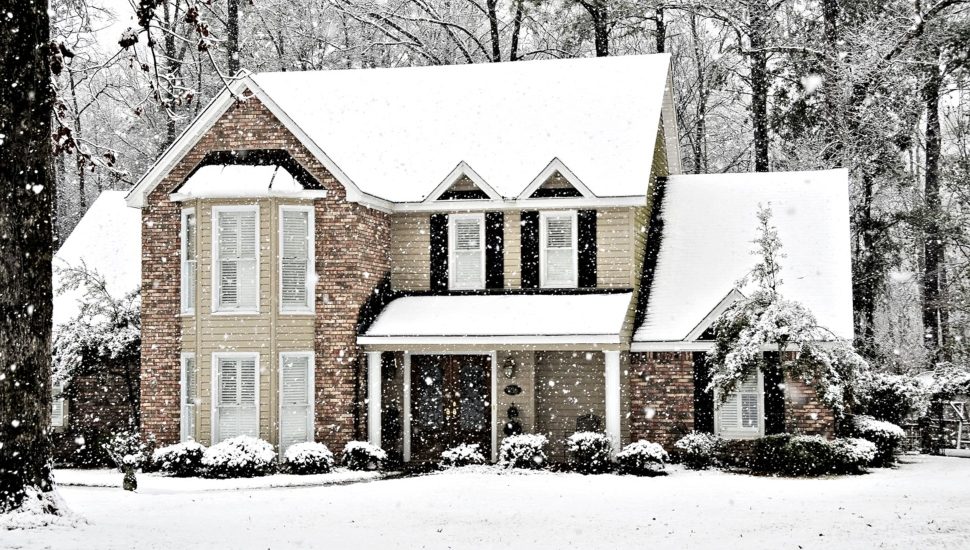Malvern Bank: Insurance Is ‘Snow’ Joke

Are you ready for winter?
For many of us, being prepared for the cold winter months means replacing your warm-weather wardrobe (shorts, swimming suits, short-sleeve shirts) with winter attire (heavy coats, sweaters, snow boots, etc.).
But what about your home? According to Covered, an independent insurance agency and digital resource for information on insurance, your home needs more than a cozy sweater or pair of slippers. Your home needs … winterizing.
Winterizing is about how you protect your home from the potential damage winter weather can cause. Damage from winter storms and freezing temperatures can be inconvenient, costly, and dangerous.
What can go wrong if you don’t winterize? And what are the insurance implications if something does go wrong?
Interior Pipes Freeze
Remember what you learned way back in middle school science? When water freezes, it expands. So, if your interior pipes are vulnerable to freezing, you could end up with burst pipes. And that could mean water leaking, spraying, or even flooding into your home. At minimum, you could end up with water damage to your furniture or other personal property. In a worst-case scenario, you could end up with structural damage to your home, ruined floors, and ceilings, or utterly destroyed plumbing.
What’s covered by your insurance? Most homeowners’ insurance policies will cover repairs or replacements caused by burst interior pipes and the subsequent water damage. That said, if the burst pipes were caused by homeowner negligence (e.g., you leave for a trip, turn off the heat in your home, and don’t do any preventive maintenance), you may not be entitled to coverage.
Failure to Drain Exterior Plumbing
If you don’t drain the water out of your exterior plumbing — water hoses, exterior taps, irrigation systems hoses — any water left inside could freeze and expand. That could mean more burst pipes, a ruined irrigation system, or hoses you’ll need to replace.
What’s covered by your insurance? Again, water damage from burst pipes may be covered by your homeowners’ insurance policy. But failing to proactively drain these items qualifies as homeowner negligence. That means coverage could be excluded.
Fallen Trees and Branches
High winds, or the weight of snow and ice, could cause a large tree branch — or even an entire tree — to fall on your home. This could result in damage to your roof, deck, or windows.
What’s covered by your insurance? For most homeowners, both the tree removal and the property damage will most likely be covered by insurance. That’s true whether it was a tree from your own yard, or a tree from your neighbor’s yard. If your tree falls on a neighbor’s house or car, however, they should file a claim under their own insurance.
Snow and Ice Accumulation Causing Roof Leaks — or Worse!
Snow is HEAVY. Also, when snow melts, that melted water has to go somewhere. This means that, either pre- or post-melting, snow and ice buildup on your roof can create some huge problems. (1) Ice dams can form when warm air in your attic melts the snow on your roof, causing it to run down and re-freeze on the roof’s cooler edges, forming ice dams. These dams can then trap snowmelt, potentially causing it to seep into your roof, walls, and ceilings. (2) Actual roof overload/collapse is less likely. But it’s absolutely possible, and it would be a huge problem requiring significant structural repairs.
What’s covered by your insurance? The resulting water damage may be covered by your homeowners’ insurance policy. Beware of letting that water damage become mold damage, however. When mold damage is the result of homeowner negligence, most homeowners’ insurance policies will not cover it.
Clogged Gutters Causing Water Damage to Ceilings and Walls
Gutters get clogged with leaves and other debris. Mix in some snow and ice, and you’ve got gutters that can’t drain much of anything. That melt water that can’t drain through the gutters could end up flowing into your foundation, siding, walls, and ceilings, causing water damage.
What’s covered by your insurance? This one’s dicey, as failing to maintain your gutters could clearly be viewed as homeowner negligence. So, while your homeowners’ insurance may provide coverage for this type of water damage, it’s nowhere near a certainty.
Neglected Exterior Damage Causing Higher Maintenance Costs
Maybe you’ve been ignoring a foreboding-looking crack in your foundation. Or maybe it’s just some smaller stuff like a couple of minor cracks in the siding or a leaky window frame. The problem is that if you’re negligent in attending to exterior damage now, you could be in for even bigger issues later: water damage, mold damage, pest infestation, and structural damage to your foundation.
What’s covered by your insurance? Again, any property damage resulting from homeowner negligence isn’t covered by your homeowners’ insurance policy. As a homeowner, you’re expected to perform reasonable maintenance to make sure that the normal wear and tear your home experiences doesn’t turn into a much bigger problem.
A Poorly Maintained Fireplace Increasing Fire Risk
Lack of fireplace maintenance poses several risks, including increased risk of chimney fires, carbon monoxide poisoning, or even bodily injury. That’s why, whether or not you plan to use your fireplace this winter, you need to winterize it.
What’s covered by your insurance? Standard homeowners’ insurance policies do not cover fireplaces. If you have a fireplace, you need to purchase fireplace coverage that can be added to your homeowners’ insurance policy. That applies even if you don’t use your fireplace.
Falling Ice Damaging Your Car
You may think those giant icicles that form on the trees around your house are awfully pretty. But they can also be dangerous — and pose a risk of expensive damage to your car.
What’s covered by your insurance? It depends on the type of automotive insurance policy you’ve purchased. If you have “comprehensive” coverage, the damage to your hood will most likely be covered.
So, while you’re getting out the winter coats, sweaters, and snow boots, think about getting your home ready for winter, too. It’ll likely save you money in the months to come.
If this article has gotten you thinking about what you should do to winterize your home — and what kind of home insurance coverage you need — contact me at 610-695-3651.
_________________

Sally Lawson is Senior Vice President/Senior Investment Advisor at Malvern Bank, National Association.
Stay Connected, Stay Informed
Subscribe for great stories in your community!
"*" indicates required fields















![ForAll_Digital-Ad_Dan_1940x300[59]](https://montco.today/wp-content/uploads/sites/2/2022/06/ForAll_Digital-Ad_Dan_1940x30059.jpg)










![95000-1023_ACJ_BannerAd[1]](https://montco.today/wp-content/uploads/sites/2/2023/03/95000-1023_ACJ_BannerAd1.jpg)















